BACK TO WEATHER-BLOG MENU
The Welsh Weather & Dyfi Valley landscapes Image-Library - Click HERE
Some readers may recall that I came across a wonderful quote or two in early 2013, while researching prior to doing a sampling programme on behalf of the University of Nova Scotia. They were looking to compare the igneous rocks of North Wales with those of the Meguma Province in that part of eastern Canada. Igneous rocks are those that have crystallised during cooling, from a molten state. They may be erupted out of a volcano - lava - or they may remain in an underground magma-chamber to cool slowly, forming granite and other rock-types, distinguished by their chemistry. Or they may solidify in narrower fissures, some flat-lying, forming sills and others steep-sided, forming dykes.
So I had to go out and locate and collect a representative batch of samples, from the part of North Wales known as the Harlech Dome, a district between Dolgellau and Porthmadog. Lots of geologists have studied and written about the rocks of this area and I was soon busy going through their writings. I came across this little gem, written by D. Forbes, in 1867:
“The very characteristic rock-species diabase does not even seem to have been recognized by the Survey, notwithstanding that it would be probably impossible to find better opportunities of studying it in all its variations of texture, crystallization, and mineral composition than in the immediate vicinity of Dolgelly. The coarse-grained varieties, with the felspar especially prominent, are quarried on the Towan road just beyond the town; the more chloritic ones are well seen in the rocks between Llaneltyd and Tyn-y-Groes; calc-diabase occurs in the mountain-side immediately above Penmaen Pool; the schistose, close-grained, and compact varieties occur everywhere; and, lastly, the magnificent Uralite porphyry, as it has been termed, forms hills alongside of the river Mawddach before coming to Tyddynglwadis.”
Anyone familiar with the district will know about "greenstones", a catch-all phrase that has been in common parlance since Forbes' time and before. They are horrible rocks - hot solutions have altered them deep underground, so that the original crystalline texture is obscured or obliterated. A lump is illustrated below. They occur mostly as sills and they are everywhere around the Harlech Dome's margins.
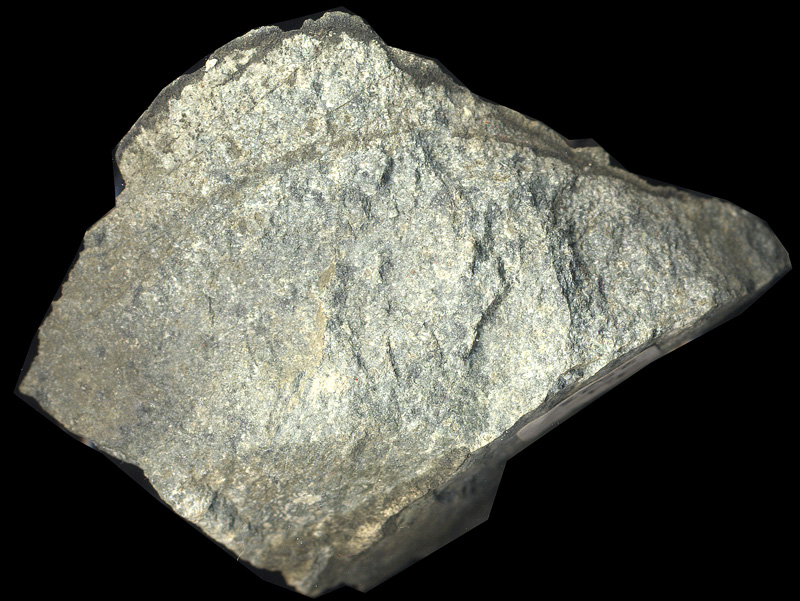
So when you read about a rock described as "magnificent", you know full well it cannot be the drab rubbish above! Forbes had given a general location - the steep sided hilly massif along the western bank of Afon Mawddach immediately above Ganllwyd, known as Cefn Deuddwr. The whole area was cloaked in dense forestry in February 2013, but there was a forest road traversing the uppermost hillside and here I found some rocks that were a bit more interesting than "greenstones":
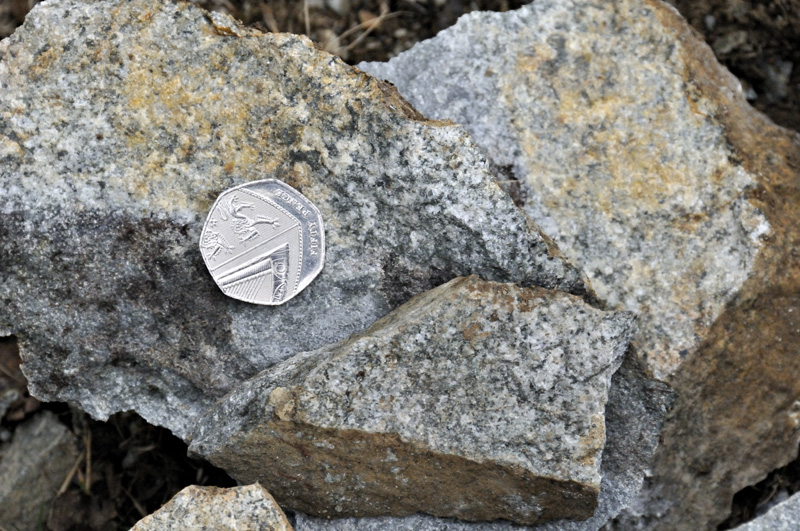
These actually retain a lot of original features as the image shows. But the word "magnificent" did not immediately spring to mind!
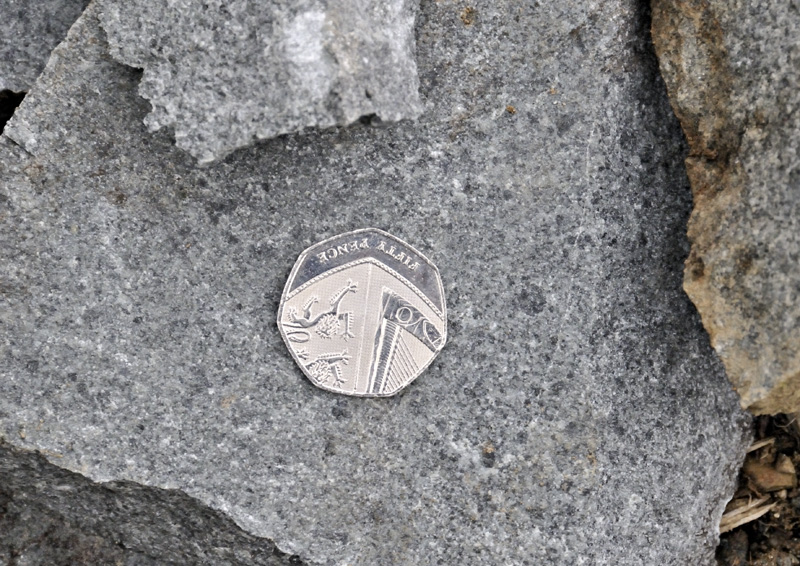
What was interesting was that they still retained mafic minerals - dark-coloured minerals containing iron and magnesium. In greenstones, such minerals tend to have long since gone. But still not magnificent...
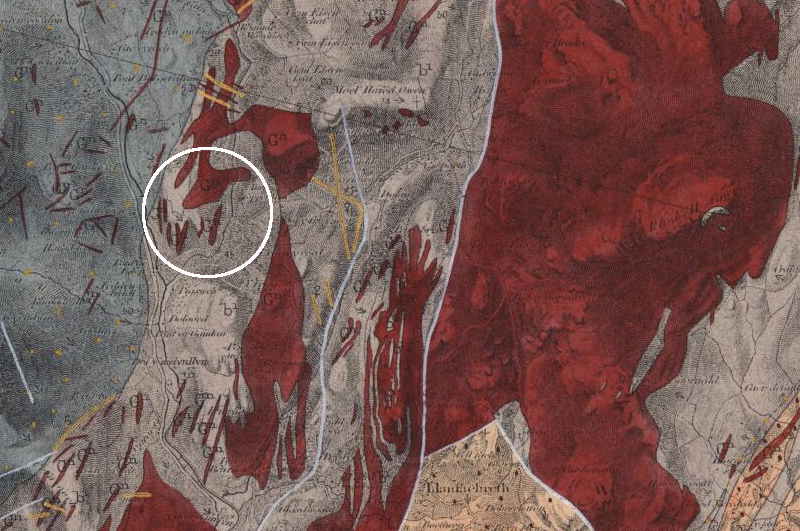
This is the district and the area circled in white is Cefn Deuddwr. The porphyry is in here somewhere, but on this 1850s geological map the intrusions (red) mostly all carry the same label! The one I sampled in 2013 is in the top half of the circle. The big red blob to the right-hand side of the map is both intrusive and eruptive igneous rocks, making up the mountain of Rhobell Fawr and its surroundings. The image below is of a polished slab of lava from Rhobell Fawr, with jet-black crystals and crystal fragments of pargasite, a mineral of the amphibole group of silicates. The green colour is caused by alteration due to hot waters that have deposited the mineral epidote. Many of the Rhobell volcanic rocks carry this colouration.
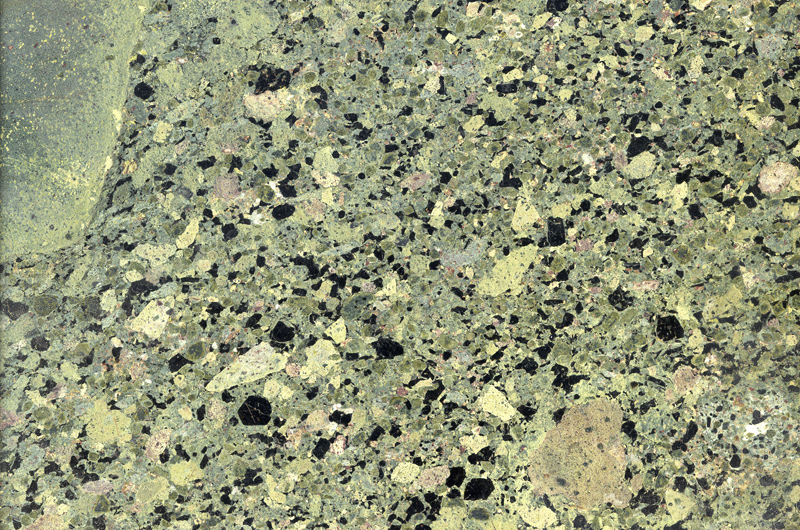
But I still had no idea where the magnificent uralite porhyry was! I started doing other things and the whole topic got parked for a while.
Then in September 2017, whilst doing a literature-search for an unrelated bit of research, I stumbled upon the following: an obscure account of an Easter 1927 Geologists' Association field-trip, led by A.H. Cox and A.K. Wells, famous geologists at that time. The party, staying in Dolgellau for several days, had been to see Gwynfynydd gold mine and:
"On the return journey to Tyn-y-Groes the route chosen followed closely the Afon Mawddach and afforded opportunity for studying the physical features of the valley. Several stages of rejuvenation were clearly recognisable, the composite nature of the valley profile being perhaps best shown near the the confluence of the Mawddach and the Eden. Those interested in igneous petrology were able to obtain excellent specimens of hornblende diorite-porphyry from blocks which had rolled from the heights of Cefn Deuddwr above. The hornblende crystals, measuring up to one inch in cross- section, were well preserved, contrasting with the rocks of the same suite seen on the outward journey on the other side of the water-parting in the morning."
Bingo! This description immediately nailed down the locality to a much smaller area, clearly situated beneath steep slopes. The only possible candidate was the hillside called Gallt Cefn Deuddwr, which is the steepest part of the Cefn Deuddwr ridge. Visiting the area a day or two later, I immediately noticed the recent clear-fell of the dense conifers that had been done by Natural Resources Wales, in association with the construction of mountain-bike trails, for which the area is incredibly popular (since writing this, I have been informed by NRW that the area had to be cleared after it was devastated during the major windstorm of February 12th 2014).
Two main outcrops could straight away be seen above the road. One turned out to be typical “greenstone”, forming a sill in the Cambrian sedimentary rocks of the Maentwrog Formation. The other, bigger outcrop, across a wilderness of recent brash, ancient thinnings, ferns and brambles, proved straight away to be what I'd been looking for all this time:
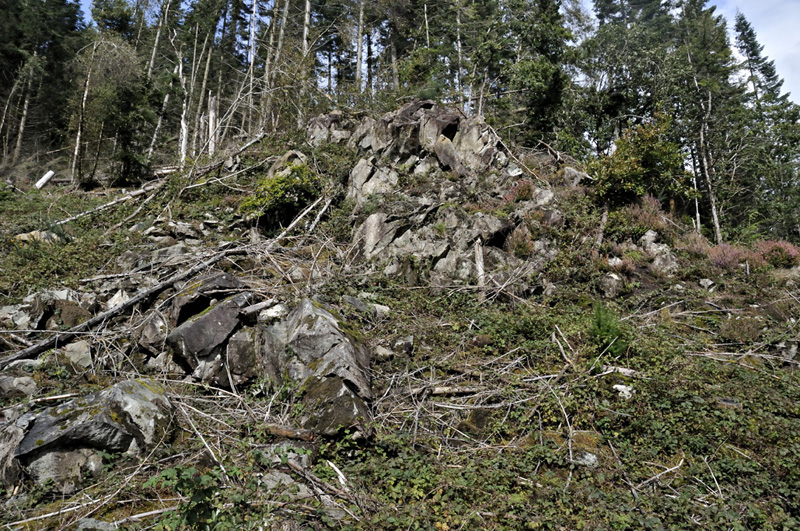
Well OK I had to get closer, but here we are:


Magnificent indeed! That 19th Century terminology was completely justified!
It's a rather variable rock, with some areas crammed with the almost black mafic crystals and other parts leaner in them.
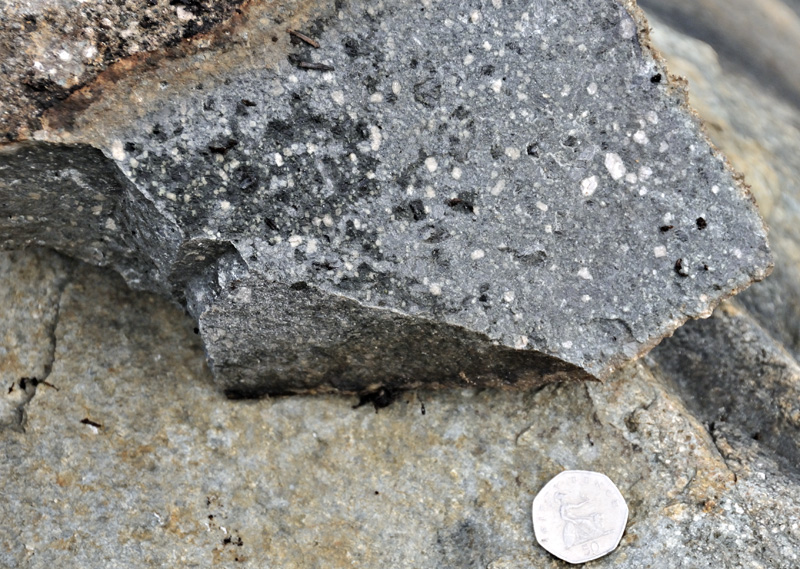
Beyond the exposure, a steep block-scree, full of the porphyry again, led up into the trees, where other outcrops are evident.
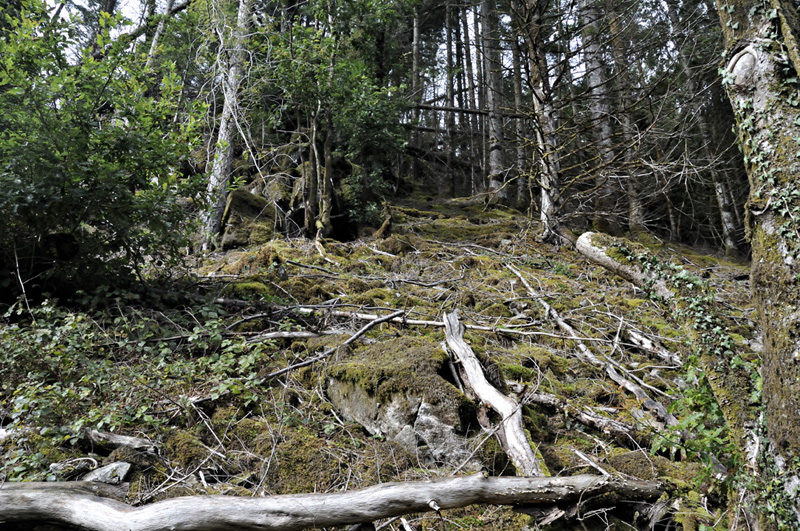
At the base of the main outcrop are bedded Maentwrog Formation rocks, dipping in a westerly direction into the hillside, pictured here. This dip is anomalous as it is almost opposite in direction to the regional dip in this part of the Harlech Dome, to the east-south-east. Either there's a fold here or the intrusion has pushed the rocks around during its emplacement. Alternatively a block of sediments has dropped off the wall of the intrusion, foundering into the magma. Unfortunately the rocks to either side are obscured by overburden.
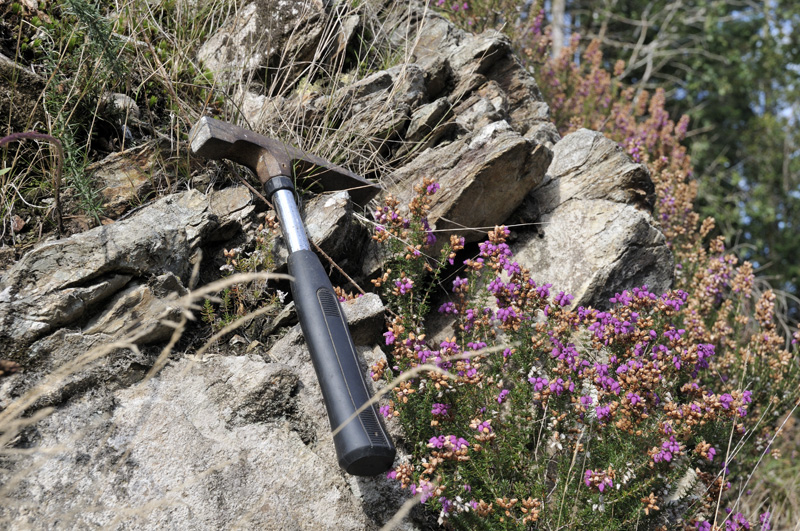
A.R. Andrew, writing in 1910, described the porphyry as follows:
"The Cefn-deuddwr rock differs from that occurring on Y Garn in the much greater size and abundance of the phenocrysts of uralite, hornblende, and orthoclase, and in its coarser texture; the individuals may be as much as 1 inch in length. The rock is composed of orthoclase, plagioclase, hornblende, uralite, chlorite, magnetite, calcite, and pyrites. Orthoclase is found in large amount both in phenocrysts and in the ground-mass. In the former it often shows a clearly marked arrangement of concentric zones on the external margin of the crystal; the orthoclase is usually cloudy, owing to the presence of calcite. Plagioclase is present sometimes, but never to such an extent as the orthoclase; it is confined to the ground-mass, where it occurs as lath - shaped albite twins, probably andesine. Hornblende, like the orthoclase, occurs in two generations, among the phenocrysts and in the ground-mass ; it is brown and strongly pleochroic. The bulk of the coloured constituent of the rock is uralite. Magnetite is a decomposition product of the hornblende, occurring along the cleavage cracks of the smaller hornblende crystals and giving a lattice-like appearance to the mineral. Pyrites may at times be very abundant in the rock, but often it is quite absent: it is perhaps of secondary origin.”
So there you have it.
How come this important rock was lost to science after the 1920s?
The next big paper on the area, by Matley and Wilson and published in 1946, gives a clue:
“Considerable areas are now being transformed to forest by the Forestry Commission, greatly to the disadvantage of the field geologist, who finds the spaces between the young trees an almost impenetrable tangle of brambles. For this reason detailed mapping of certain areas has had to be omitted.”
The same authors go on to say:
“The porphyry group included uralite-porphyries from Y Garn and Cefn-deuddwr, which were stated to contain phenocrysts of orthoclase, uralite and hornblende. These have not yet been re-examined.”
And from thereon in they were forgotten: the 1985 British Geological Survey memoir for the geological map of this area, part of the Harlech sheet, did not mention them.
Coed y Brenin was planted with dense conifers from the 1920s onwards and it would not have taken long for such rock-exposures to become hidden. Thereon in, the Magnificent Uralite Porphyry appears to have lain hidden, like the One Ring, for many decades, until the chance coincidence of narrowing down the locality and clear-felling in exactly the right spot made its rediscovery possible.
The interesting thing is that its black-flecked appearance is rather reminiscent of those Rhobell lavas, but without the green epidote-colouration. How the two are related, however, will require further research and that means laboratory work and the involvement of igneous specialists. But it was an interesting chase, all the same!
During the recent fieldwork, I also made another, lower traverse across the bigger intrusion I had sampled in 2013 and encountered an interesting variant of it:

The rock has the same pale colour but it is rich in xenoliths, these being fragments of a pre-existing solid rock that became incorporated into the magma as it made its way to its final position, where it cooled and solidified, trapping the fragments within itself. There's an awful lot to see in this relatively small corner of the Welsh landscape.
In researching all of this, I came across another 19th Century quote, from an 1893 paper on Rhobell Fawr itself:
"The examination of early Palaeozoic lavas is sometimes more irritating than conclusive."
Not on this occasion, it wasn't. We'll have to see what the geochemists now come up with. But I know one thing. You cannot call this rock a "greenstone", any more than you can describe the best artworks of the world as "pictures".
The Welsh Weather & Dyfi Valley landscapes Image-Library - Click HERE
BACK TO WEATHER-BLOG MENU